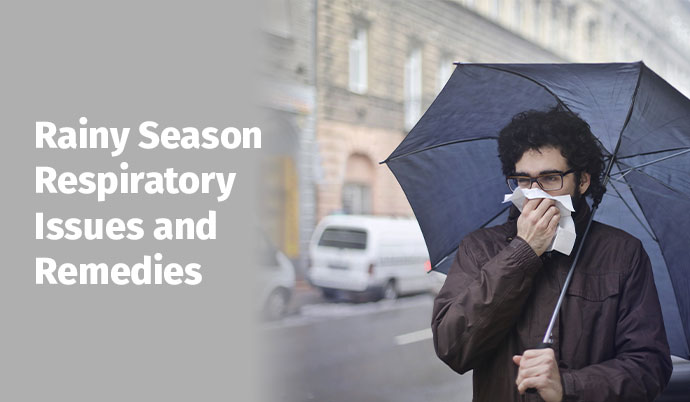
The National Centre for Disease Control (NCDC) has recorded a sudden increase in respiratory infections in the monsoon season, and nearly 30 to 35% of reported diseases in India are attributed to upper and lower respiratory tract infections. This, already combined with the damp air, impending molds, rapid fluctuation in temperature and an increase in air pollution caused by both traffic and construction blockades and what you have is a convenient mix of coughs, colds, and long-term wheezing.
Rainy season is not just a mere season of nostalgia in a country where over 18 million people presently suffer from asthma, and COPD (Chronic Obstructive Pulmonary Disease) occupies the second position on the number of deaths list; it is more about learning to take care of the lungs as an expert.
So, here are the predominant respiratory problems that increase during this period, their reasons, and homemade, science-supported solutions to inhale even when the skies are cloudy.
General Respiratory Problems in the Rainy Season
a) Allergies Rhinitis
Allergies Rhinitis may feel like a fancy name, but the doctors from the best chest medicine hospital in Delhi will tell you that what you think is a never-ending cold. The usual symptoms include:
Allergic rhinitis occurs upon exposure to pollen, mold spores, and dust mites that usually flourish in a humid environment and have millions of victims annually among children and the elderly.
b) Bronchitis
Monsoon air usually contains ejected pollutants and bacterial allergens, which irritate the bronchial vesicles, thus causing inflammation. The result? Coughing, mucus, wheezing and chest constriction. While smoking and low immunity make an individual more susceptible to this issue.
c) Asthma Attacks
The erratic changes in humidity may prove to be a nightmare for an asthma patient. Mold, cold air, and dust do the same thing and exacerbate the escalation of asthma attacks.
According to the Global Asthma Report 2022, India bears 12.9% of the global burden of asthma, and disappointingly, not more than 30% of sufferers are adequately diagnosed and treated.
d) Pneumonia
Pneumonia, which is a more serious condition, gets rife during the monsoons. The lungs are a readily arrested target with stagnant water in the air and an increase in viral and bacterial activity. The highest risks are in young children below 5 years and older adults. UNICEF calculates that more than 1,27,000 children under five die in India every year because of pneumonia.
e) Sinusitis
Once your sinus passages are blocked by infection or allergies, you are prone to facial
pressure, headaches, and post-nasal drips. Due to the humidity of the atmosphere, fungal growth takes place, causing sinusitis to be a tenacious ally during the seasons.
Why does the Rainy Season worsen the Respiratory Issues?
It is time for us to play a game of detective about why our lungs dislike the rain, even though our hearts don’t.
Natural Remedies and Prevention Strategies
Leave the instant antidote antibiotics behind. Consider that there must be a reason why the nuskhas of our grandmothers have been around generation after generation. This is some sort of a compromise between ancient customs and contemporary science to solve the madness of the monsoons:
a) Steam inhalation
This is a classic, but gold, steam or tulsi leaves or ajwain (carom seeds), or even a drop of eucalyptus oil may:
Practice this two times a day, for 5-10 minutes, especially before going to bed.
b) Turmeric Milk (Haldi Doodh)
Turmeric is anti-inflammatory and generally an invincible spice. Mix 1 teaspoonful in hot milk with black pepper (to augment absorption). Take it at bedtime and say goodbye to any infectious issue.
c) Honey Ginger Combo
The ginger contains gingerol and lowers inflammation of the airways, and honey is a natural suppressant of the cough.
One teaspoonful of fresh ginger juice mixed with honey = relief of throat pain.
d) Tea of Mulethi (Licorice Root)
Mulethi is demulcent in nature as it exerts a cushioning effect on the mucous membranes and alleviates sore throat and cough.
e) Oil of Oregano
Oregano oil is potent with antimicrobial characteristics and can fight infections in the respiratory system. Add drops of oregano oil to hot water for steam use.
Immunity Boosters
The fight you avoid is the best one. Boost your immunity by eating and doing habits that protect your respiratory system:
Smart Tips for Lung-Care in Monsoon
The basics should not be underrated. By following these important smart tips, you can take care of your lungs this monsoon.
When To Visit a Specialist?
You may be as kadha-dodgers as you like, but when you are:
Consult a specialist and book an appointment at Sir Ganga Ram Hospital today. As antibiotic use or self-medication can be harmful than helpful. Keep in mind that WebMD is not an MBBS degree.
Kids and Aged Adults are the Most Susceptible to Respiratory Issues
Both the young and the elderly require additional care and treatment during the rainy season.
For Kids:
For Elders:
It is cheerful and refreshing to dance in the rain, but do not forget to breathe smart.
Monsoon in India is magic; magic only when you do not have to cough your way through it. The right awareness, the right amount of kitchen magic, some tampering with the lifestyle, and the proper care of your pair of lungs can easily help you to move forward in such
weather. There is nothing you can do about the rains, but when it comes to respiratory misery, you do not have to put up with it. Cheers to long, deep breaths, less sneezing, and lungs that could tolerate Indian weather like a pro. For timely treatment and care, book an appointment at Sir Ganga Ram Hospital today.




